Payhip is an ecommerce platform that lets creators sell and physical digital products directly to their audience. Learn how it works and whether it’s worth using.
Key takeaways
- Payhip is a UK-based ecommerce platform founded in 2011 for selling digital and physical products.
- The platform offers free registration with no payment information required upfront.
- Payhip provides limited customization options compared to WooCommerce and Shopify platforms.
- Customer support is email-only with mixed reviews averaging 3.1 out of 5 stars.
- The platform automatically handles VAT calculations and reporting for EU and UK sales.
Payhip is an ecommerce platform for creators who want to sell physical products and digital products like ebooks, courses, and memberships.
The platform handles everything from payments to delivery, making it easy to launch a store without technical skills. But it does have it's limitations - basic customization, limited SEO tools, and email-only support.
Here's what you need to know about Payhip and whether it's the right fit for your business.
What is Payhip?
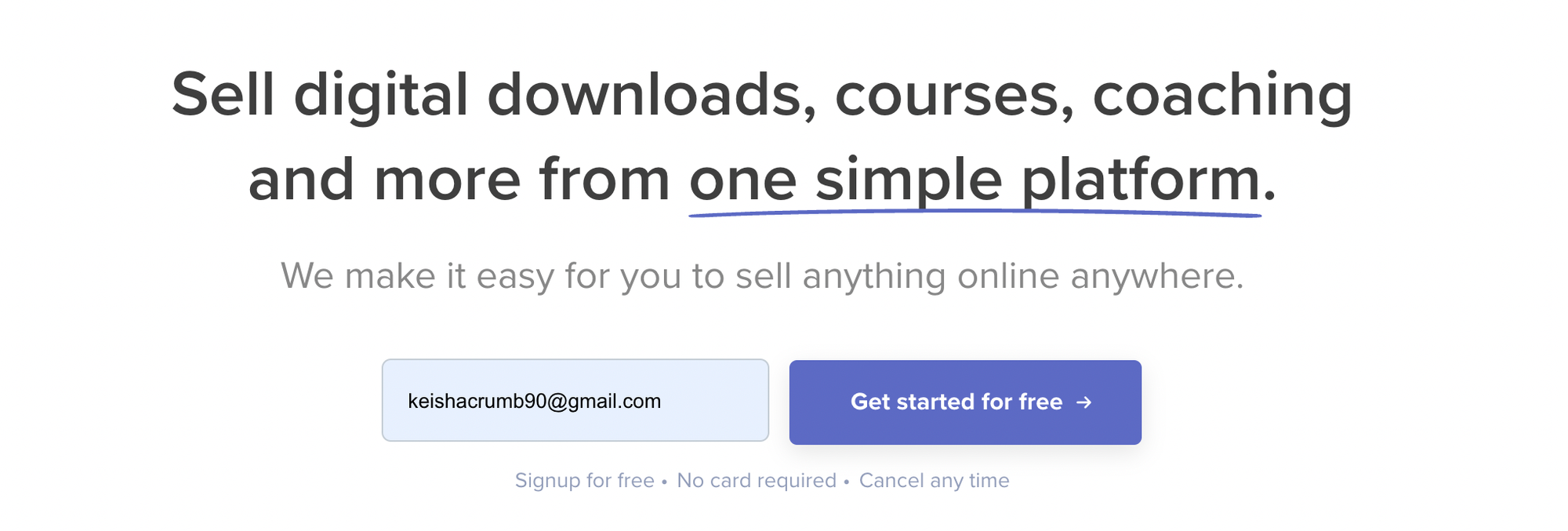
Payhip is a UK-based digital commerce platform that lets creators sell digital and physical products directly to their audience.
Founded in 2011 as one of the first tools built for online creators, Payhip quickly gained traction among coaches, writers, and entrepreneurs looking for a simple, reliable way to sell products without technical setup.
More than a decade later, its focus remains the same: helping creators easily sell ebooks, courses, memberships, and more, all from one platform.
What is Payhip used for?
Payhip's target audience is anyone who wants to sell online. The platform markets itself as a simple way to get started with ecommerce, while promising to be able to grow and scale as your business evolves.
Today, there are dozens of SaaS platforms targeting specific niches, such as course creators, podcasters, or social media influencers. Payhip can cater to those individuals, but the platform works best as a fully-featured online store.
How to sell on Payhip
As a seller, it's easy to get started with Payhip. You can sign up for the platform for free and without having to provide any payment information. Then you add products, customize your store, configure payments and manage access.
Here's how to sell in Payhip in more detail:
Registering for Payhip
All you'll be asked for on registration is your name and email address.
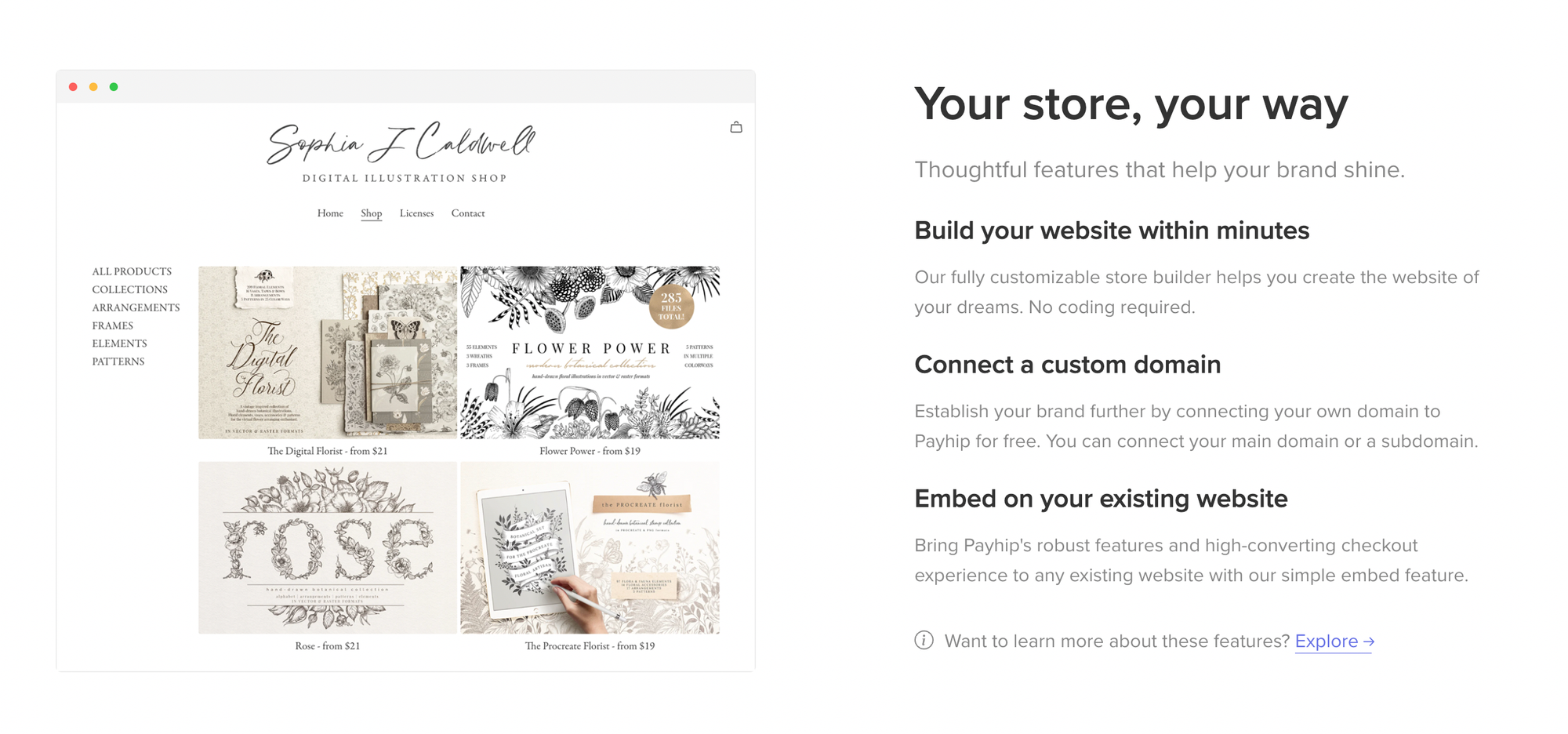
After registration, you'll be asked to provide a name for your store. This will be used as part of your store's address in the format https://payhip.com/STORENAME, so if you're not planning on using a custom domain when you launch your store, choose the name carefully.
Custom domains are available to all users, and Payhip doesn't charge you anything for configuring one, although you will have to purchase the domain from a third party such as GoDaddy or FX Domains.
The annual fee for a domain name isn't particularly expensive, however, and they make your store appear far more professional, so it's worth spending the money if you're serious about running an online store.
Adding products
Once you've picked a name for your store, you'll be taken to a setup page that asks you to do three things:
- Add your first product
- Set up your payment options
- Customize the layout of your store
You will then be asked to upload your product. Payhip supports several products, including:
- Digital products (e.g. ebooks or software)
- Courses
- Memberships
- Physical products
- Coaching services
You can also bundle multiple products together to sell for one price.
Once you have chosen your product type, you simply upload it, enter a title and price, upload a cover image, and choose the visibility of your product.

After choosing your product type, Payhip walks you through a tailored setup process for each format.
- For digital products, you'll upload your files and set basic details.
- Course creators get access to a curriculum builder for organizing lessons and modules.
- Membership sellers can create different tiers with varying access levels.
Managing products
Payhip makes it easy to manage products directly from your dashboard. You can upload digital files, set prices, and even bundle products together.
For physical products, you can track inventory levels and get alerts when you're running low.
You also get the flexibility to customize your shipping options. Whether you prefer flat-rate shipping, offering free shipping for certain order values, or calculating rates based on weight and total value, Payhip lets you tailor everything to your business needs.
Customizing your store
With Payhip, you can also configure the look and feel of your store. The default store theme is a minimalistic one with a white background and black text.
It's quite neat and easy to use, but may not match your brand. To customize your store, click on the banner that reminds you to complete your store setup, and choose the Customize your store option.
The store builder helps you organize your products into collections for easier browsing. You can create blog posts to share updates, add custom pages for business information, and adjust your store's appearance with different fonts and colors.
Your store automatically adapts to mobile devices, making it easy for customers to browse and buy from their phones.
Configuring payments
To get started with accepting payments on Payhip, you can easily link your store to PayPal or Stripe.
These two popular payment processors give your customers the flexibility to pay using credit cards, debit cards, or their PayPal accounts. Payhip walks you through the connection process, so it’s quick and straightforward.
Once set up, you can manage your payment settings directly from your Payhip dashboard. This includes configuring your preferred payment methods and reviewing transaction details.
Payhip also handles all the security for you. Keep in mind that Payhip charges a transaction fee based on your plan, which is in addition to any fees from PayPal or Stripe.
Managing delivery and access
Payhip automates the delivery process for everything you sell. Each product type has its own delivery setup:
- Digital products: Instant download access after purchase
- Courses: Login details to access curriculum
- Memberships: Secure access to member-only content
- Physical products: Tracking information for shipments
The platform creates specific spaces for your customers based on what they've purchased.
Digital products go into a secure download area, courses get a dedicated learning space, and memberships have their own access zones. The whole system runs automatically, letting you focus on running your business.
Payhip features and capabilities
Getting your store set up is just the first step. Now let's explore what you can actually do with Payhip. From essential ecommerce features to marketing tools, the platform offers various capabilities to help you sell and manage your digital products.
Payhip ecommerce tools
Payhip's ecommerce tools are quite comprehensive. It supports most common product types and has an intuitive store builder. It also offers some other useful features, including:
- Affiliate programs
- Flexible pricing with bundles, discounts and subscriptions
- Integrate the Payhip checkout with your existing website
- Cross-selling and other marketing features
- Third-party integrations for email marketing
However, the platform has some limitations.
For one, the customization options are quite limited. You can change the color scheme and have a reasonable amount of control over how products are grouped together, but there aren't many options for customizing the layout of your store.
Some other store platforms, such as WooCommerce and Shopify offer a far higher degree of control over how the store looks and feels.
If you want a lot of control over your store's branding, you might find Payhip disappointing.
Memberships and subscriptions
With Payhip, you can create multiple membership tiers or subscription plans, each with its own pricing and perks.
For example, you might offer a basic monthly plan with access to exclusive content or a premium tier that includes one-on-one coaching. Billing is automated through Stripe or PayPal, so you don’t need to manually process payments.
Subscribers also get the flexibility to manage their plans directly, which reduces administrative headaches for you.
This feature works well for creators offering ongoing services, like private communities, newsletters, or educational content.
You can also tie subscriptions to digital products, like courses or downloadable resources, creating even more value for your subscribers.
Marketing and SEO
Payhip gives you basic tools to start selling, but you'll need to drive your own traffic to your store. While you can create blog posts and embed products on your existing website, the platform has limited SEO capabilities.
You can't customize URLs or set meta descriptions, which might affect your store's visibility in search results.
The platform works well if you already have an audience through social media, email lists, or your own website. You can embed Payhip's checkout on your existing site or share product links directly with your followers.
Analytics and reporting
Payhip provides an analytics dashboard that shows your daily views and sales at a glance. You can select specific products or view your entire store's performance over different time periods.
The platform shows you where your customers come from by tracking your top visitor sources. You can see which marketing channels drive the most traffic and sales to your store. For each product, you'll find key metrics like page views, number of orders, and total revenue generated.
Payhip also includes a visual map showing where your customers are located globally. While the analytics features are basic compared to some ecommerce platforms, they cover the essential metrics you need to track your store's growth and make informed decisions about your product strategy.
Customer communication
Payhip sends automated emails after each sale with purchase details, access instructions, and welcome messages. You can customize these communications to include the information your customers need to get started with their purchases.
The platform provides dedicated areas where your customers can access their purchases. Course students can use their dashboard to work through lessons, membership holders can access their exclusive content, and digital product buyers can find their downloads in one place. This organization helps your customers easily find everything they've bought from your store.
Security and tax compliance
Running a digital product business comes with important considerations around keeping your content secure and managing taxes properly. Payhip has built-in features to handle both, reducing the time and effort it takes to manage these tasks.
The platform automatically stamps every PDF you sell with the buyer's email address. This helps you track where your files go and prevents unauthorized sharing.
For software, Payhip generates unique license keys that restrict access to paying customers only and help protect your product. You can also set download limits and expiration dates to control how your digital files are used.
Creators using Payhip also benefit from automated VAT calculations and reporting for EU and UK sales. The platform collects and remits the correct amounts directly to tax authorities. For other regions, Payhip provides tools to set up custom tax rates and collect taxes based on your customer's location, though you'll need to handle the actual tax reporting yourself.
Contacting Payhip: customer service avenues
If you run into any problems, you can contact support by email.
The contact details are easy to find, being displayed prominently on the welcome banner, and as a link in the footer on all pages of the website. Still, there is no option to call Payhip, meaning that you have to rely on email support, which is not ideal when you're running a business through the platform.
Unfortunately, customer feedback is mixed, with a 3.1 out of 5-star review on Trust Pilot. Many customers report slow page loading times and other minor issues with the platform.
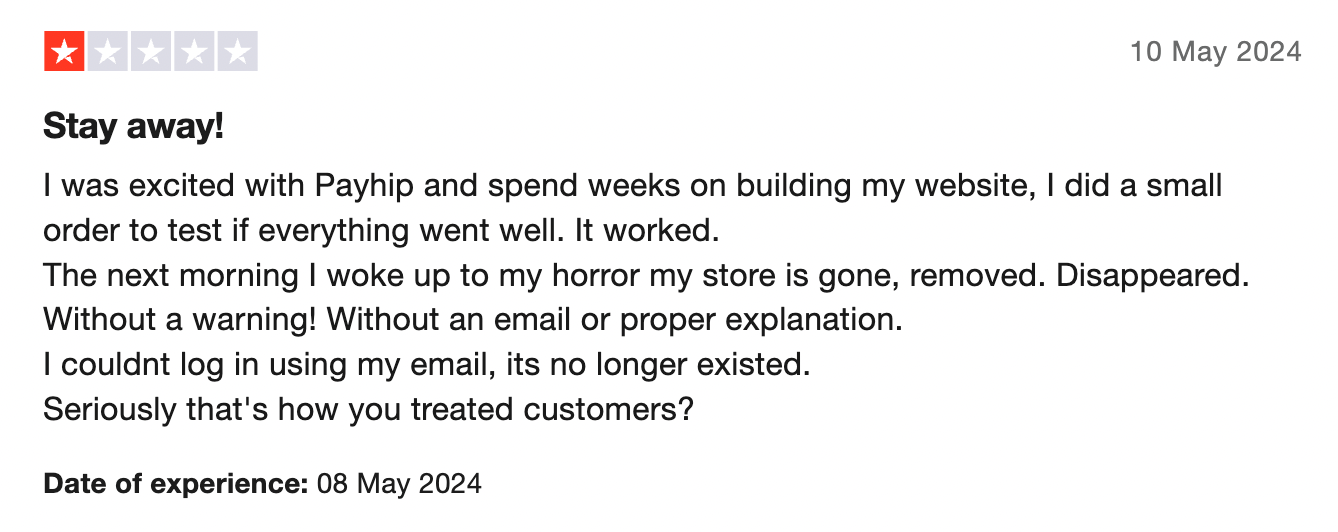

More worryingly, there are reports of creators investing time to set up a store or create a course, then having their store removed without warning.
It's possible some of those users violated the terms of service, but the lack of communication from the support team is still cause for concern. Then, there are complaints of the lack of customer service and not being paid out funds.
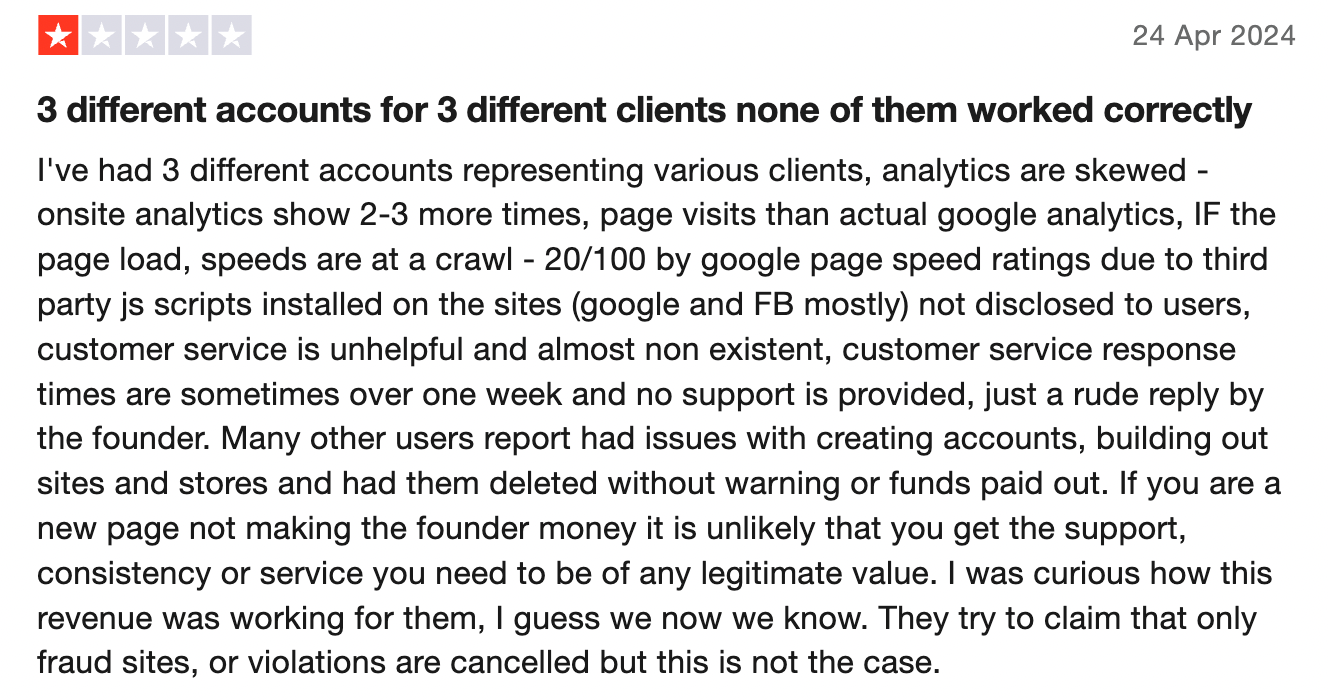
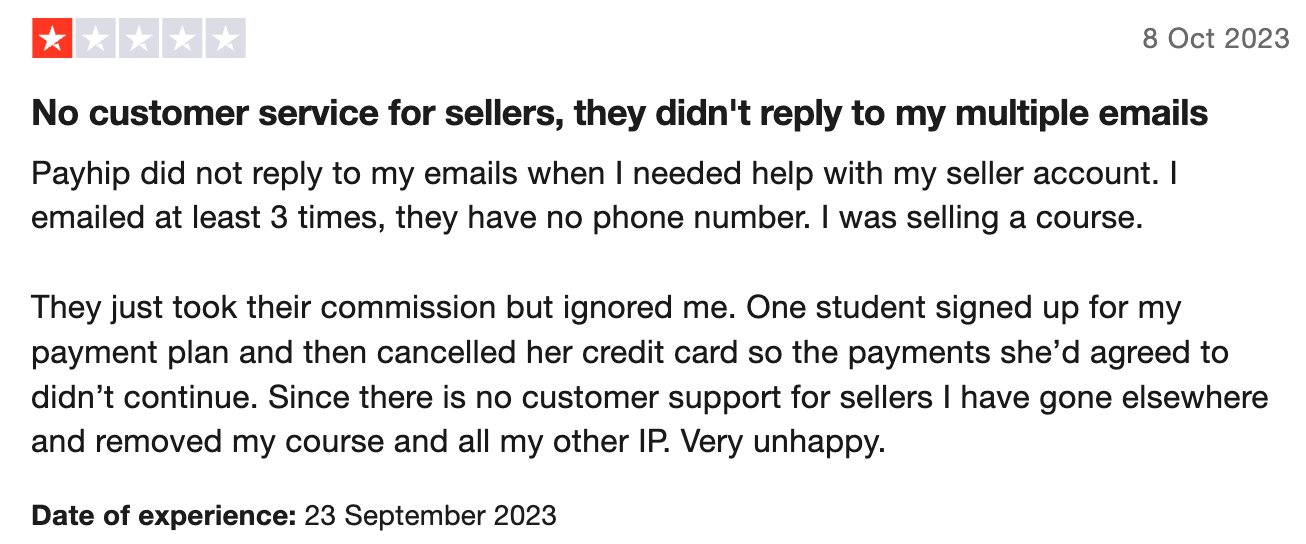
How much does Payhip cost?
Payhip stands out in the ecommerce space for offering a free forever plan that includes access to all features and unlimited product uploads. Instead of charging monthly, Payhip takes a 5% transaction fee on each sale (plus standard payment processor fees from Stripe or PayPal).
This free plan is ideal for new or small creators testing the waters. As your sales grow, you can upgrade to reduce or remove fees:
- Payhip Plus: $29/month, with a 2% transaction fee
- Payhip Pro: $99/month, with no transaction fees
All plans include the same core features - courses, memberships, digital downloads, physical products, and more. The only difference is how much you pay per sale.
Payhip also supports video hosting for creators who sell courses or video products. You can upload and stream videos directly through the platform, or embed them from YouTube or Vimeo at no extra cost.
If you need advanced bandwidth or storage beyond the default limits, Payhip offers custom options through its support team.
Payhip pros and cons
Still unable to decide whether Payhip is right for you? Here's a look at its main strengths and limitations based on our testing:
Payhip pros:
- No technical knowledge required: The platform's simple interface lets you set up your store and start selling without any coding or design skills.
- All features on free plan: Unlike many platforms, Payhip gives you access to all features regardless of your plan level.
- Automated tax management: The platform handles EU/UK VAT calculations and reporting automatically, reducing administrative work.
- Built-in security features: PDF stamping and license key generation help protect your digital products from unauthorized sharing.
- Integration flexibility: You can embed Payhip's checkout on your existing website or share product links directly with your audience.
Payhip cons:
- Limited store customization: Basic design options restrict how much you can customize your store's appearance and layout.
- Basic analytics: The reporting tools provide essential metrics but lack advanced features for detailed business insights.
- Additional transaction fees: The platform charges 5% on the free plan and 2% on Plus plan on top of payment processor fees.
- Limited support options: Email-only support means you might wait longer for help with urgent issues.
Limited SEO capabilities: You can't customize URLs or set meta descriptions, which affects your store's search visibility.
Payhip alternatives
The top Payhip alternatives are Gumroad, Shopify, and Whop,
While Payhip is a good option for newcomers to the world of ecommerce, the platform's limited customization options and slow performance is not ideal for those looking to grow their businesses to high levels of success.
Gumroad

Gumroad is a popular platform with digital content creators. On paper, Gumroad costs more than Payhip, with the platform taking a higher commission out of any sales. It also has even more limited customization options.
However, it offers some nice extra features, including a busy marketplace and free online marketing features.
If you don't have a lot of reach to market directly to your target audience and want the discoverability that comes with being part of a large, popular marketplace on a trusted platform, choosing Gumroad could work out well for you.
Gumroad vs. Payhip: Which platform is best for digital products?
Shopify
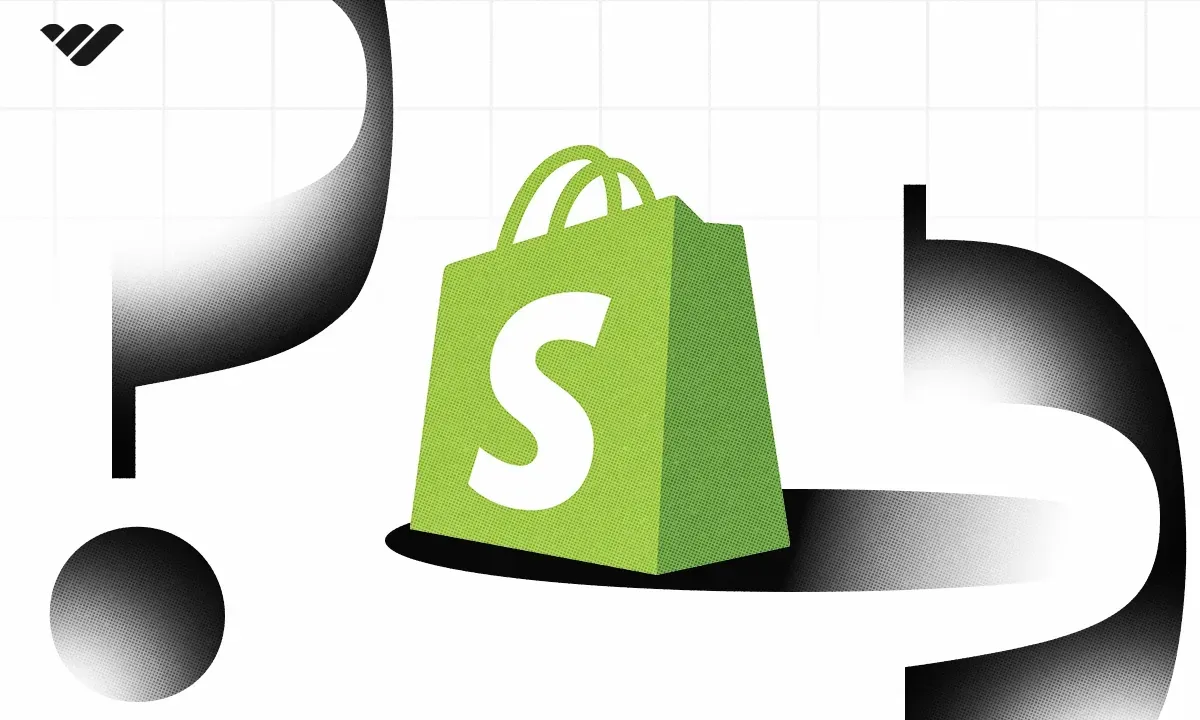
Shopify is primarily designed for entrepreneurs who want to sell physical products or do dropshipping. It can be used for digital downloads or courses but requires plugins for this.
Shopify is far more expensive than Payhip and while it's easy to get started with, the learning curve for customizing the store is steep.
🥇Whop: the ultimate Payhip alternative
Whop is a modern social commerce platform built for creators who want to sell anything online - memberships, communities, courses, chats, and more - all in one place.
Unlike Payhip, Whop isn’t just a storefront. It’s an all-in-one system for hosting, managing, and growing your audience. You can create a whop (your online business), invite members, and start earning immediately - with no monthly fees and a low 2.7% commission.
Everything happens inside your whop: content, payments, analytics, and community. Whether you’re selling access to a group chat, an online course, or premium resources, Whop gives you the tools to build it, sell it, and scale it, all under one roof.
Ready to see why thousands of creators are switching?



